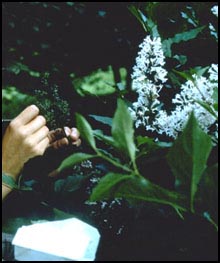





 | |||||||
|
|||||||
 | |||||||
|
In its Balkan home, the common lilac bears flowers with single, four lobed,
pale purple corollas. Breeders have increased individual floret size, produced
a range of shapes, and developed a variety of colours. They have also bred for
double florets, unusually coloured or shaped foliage, disease resistance and more.
The lilac is a living testimony to the innovation of plant breeders worldwide.
|
Four steps to plant parenthood Human understanding of genetics revolutionized the plant world in the last decades of the 19th century. Then, as now, breeders simply chose two plants with desirable traits and crossed them to see if these characteristics would be enhanced in the offspring. 1. Choose which plant is to be the mother (seed parent) and which is to be the father (pollen parent). Remove the pollen-filled anthers to expose the tiny female stigma on the mother flower. 2. Paint pollen from the father plant on to the stigma of the mother, then bag the bloom to ensure that other pollen does not contaminate it. 3. Wait for seeds to ripen, then collect and plant them. 4. Wait three or more years until they bloom to see if any offspring have the desired traits. |
|||||||||||||||||
|
||||||||||||||||||
 Preston
Preston